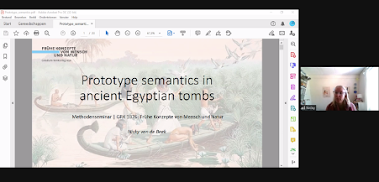“Prototype Semantics in the ancient Egyptian tombs” a presentation by Nicky van de Beek as part of the Methodenseminar
A Blog-post by Yossra Ibrahim
On 12 February 2021, Nicky van de Beek (an Egyptologist and a doctoral candidate since October 2020) virtually presented an interesting method she is currently utilizing for her doctoral research project.
Nicky’s research focuses on the Ancient Egyptian landscape in the Old Kingdom tomb scenes. For this purpose, she is utilising a method known as Prototype Semantics. This method suggests that in visual evidence depicting several categories or several figures, there are central figures or figures that occupy a more important or central role than others. In other words, prototype theory is a broader theory of categorization that favors some figures more than others; for instance, a dog is more likely conceived as a pet than a snake, at least in the ancient Egyptian perspective.
A category can be understood as a “family” in which not all its members have the same attributes and characteristics. In the same sense, a category does not consist of all essential characteristics shared by all members of the same category, but they have a number of overlapping similarities and common attributes.
Further on, Nicky opened up a very interesting discussion about the ancient Egyptian language and how language shapes our conceptions and understanding. In her research, Nicky discovered that the basic form of language is action and meaning communicated through words. To illustrate her ideas, Nicky gave us a short lesson on ancient Egyptian hieroglyphs.
The most emphasised point was that a single hieroglyphic sign can have different roles, i.e., communicate different meanings by adding determinatives. Consequently, scholars as Orly Goldwasser raised the question of the role and importance of determinatives (Goldwasser; 2012). These determinatives clarify the meaning of words, they are silent signs added at the end of a word to provide substantial information. Thus, Goldwasser suggests a more accurate term for determinative: “classifiers”, as they represent a semantic classification system. Determinatives therefore not only clarify the meaning of a word, but also have a semantic link to the associated words.
Despite the fact that these two marshland scenes (fig. 4) show great resemblance; yet, distinction can be drawn especially in regards to the form/structure. To illustrate this point both scenes highlight the elite social status of the tomb owner; however, the composition and the scene, the action and the accompanying elements are quite different. This shows that the configuration of status has not changed much over time.
Finally, Nicky illustrated that the inscriptions accompanying the figures and scenes on the tomb walls not only communicate and record information, but each individual sign show a high level of detail to the extant that the ancient Egyptian word for fish (mḥyt) depicts different species of fish, that can be identified as mullet, puffer fish and catfish.
Figure 5. Showing how the ancient Egyptian word for fish depicts several fish species
Figure 6. Mapping the Semantics Geographically








Kommentare
Kommentar veröffentlichen